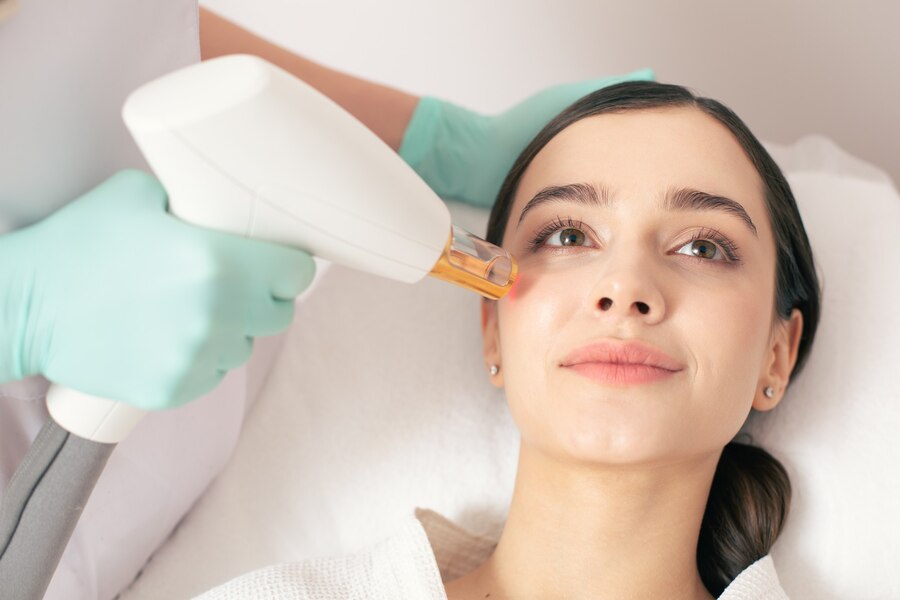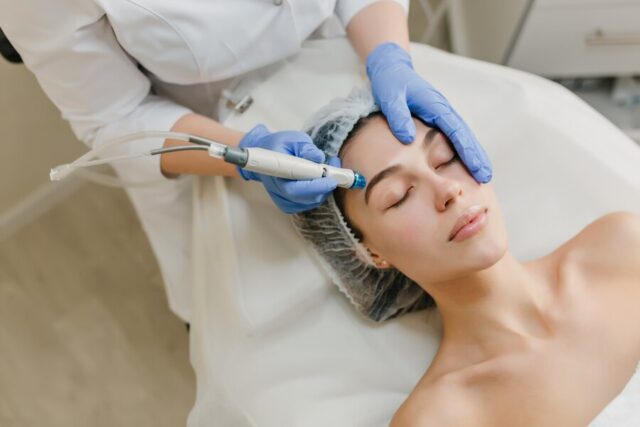Microneedling for Skin Tightening: Improving Elasticity

Microneedling for Skin Tightening: Improving Elasticity
In the pursuit of youthful, radiant skin, microneedling has emerged as a promising solution. This minimally invasive procedure involves the use of fine needles to create controlled micro-injuries in the skin, stimulating collagen and elastin production. Beyond its well-known benefits for addressing scars and wrinkles, microneedling also proves to be a powerful tool for enhancing skin elasticity. By encouraging the body’s natural healing response, microneedling helps tighten the skin, resulting in a firmer, more youthful appearance. In this blog, we’ll delve into the science behind microneedling’s skin-tightening effects and explore its potential as a key component in your skincare regimen. Say goodbye to sagging skin and hello to a revitalized complexion with microneedling.
Understanding Microneedling: A Primer
Microneedling, also known as collagen induction therapy, is a minimally invasive cosmetic procedure that involves the use of fine needles to create controlled micro-injuries in the skin. The concept behind microneedling is to stimulate the skin’s natural healing process, leading to collagen and elastin production. Collagen is a protein that provides structure to the skin, while elastin allows it to stretch and snap back into place. By promoting the production of these essential components, microneedling helps improve skin texture, firmness, and overall appearance.
During a microneedling session, a trained skincare professional will use a handheld device equipped with tiny needles to create micro-injuries on the surface of the skin. These micro-injuries are superficial and typically painless, but they trigger the body’s wound healing response. As the skin repairs itself, it produces new collagen and elastin, leading to smoother, firmer skin over time.
The Science of Skin Tightening
Skin tightening is a process that involves restoring firmness and elasticity to the skin, often addressing issues such as sagging, wrinkles, and loss of volume. Understanding the science behind skin tightening can help demystify how various treatments work to achieve these goals.
At the core of skin tightening is collagen, a protein that provides structural support to the skin. Collagen fibers are responsible for maintaining the skin’s firmness and resilience. As we age, the production of collagen naturally declines, leading to a loss of elasticity and the formation of wrinkles and fine lines. Microneedling is one such treatment that harnesses the body’s natural healing process to stimulate collagen production. The micro-injuries created by the tiny needles trigger the skin’s wound healing response, prompting the production of new collagen and elastin. Over time, this leads to tighter, firmer skin with improved texture and tone.
How Microneedling Boosts Collagen Production
Collagen is a crucial protein that provides structural support to the skin, giving it strength and elasticity. As we age, the production of collagen naturally declines, leading to a loss of firmness and the formation of wrinkles and fine lines. Microneedling is a cosmetic procedure that effectively boosts collagen production, helping to rejuvenate the skin and improve its overall appearance.
During a microneedling session, a trained professional uses a handheld device equipped with fine needles to create controlled micro-injuries in the skin. These micro-injuries trigger the body’s natural healing response, stimulating the production of new collagen and elastin. Over time, as the skin repairs itself, it becomes firmer, smoother, and more youthful-looking.
Exploring the Role of Elastin in Skin Elasticity
Elastin is another essential protein found in the skin, playing a critical role in its elasticity and resilience. While collagen provides structural support, elastin allows the skin to stretch and recoil, enabling it to maintain its shape and bounce back after being stretched or compressed. Understanding the role of elastin in skin elasticity is key to comprehending how treatments like microneedling can improve the overall firmness and suppleness of the skin.
As we age, the production of elastin, like collagen, naturally declines, leading to a loss of elasticity and the formation of sagging skin and wrinkles. Microneedling addresses this issue by stimulating the production of new elastin fibers, along with collagen, through the process of controlled micro-injury. During a microneedling session, the tiny needles create micro-injuries in the skin, triggering the body’s wound healing response. As the skin repairs itself, it produces new elastin fibers, restoring elasticity and firmness to the treated area. Over time, this leads to smoother, tighter skin with improved resilience and bounce.
Microneedling vs. Traditional Skin Tightening Methods
In the quest for tighter, more youthful-looking skin, individuals have a variety of options to choose from, ranging from traditional skincare products to advanced cosmetic procedures. Microneedling is one such treatment that has gained popularity in recent years for its ability to improve skin elasticity and firmness. However, how does microneedling compare to traditional skin tightening methods?
Traditional skin tightening methods often rely on topical creams and serums that claim to firm and lift the skin. While these products may provide temporary improvements in skin texture and tone, they often lack the ability to address underlying issues such as collagen and elastin loss.
What to Expect During a Microneedling Session
Microneedling is a minimally invasive cosmetic procedure that can help improve the appearance of the skin by stimulating collagen and elastin production. If you’re considering microneedling, it’s important to understand what to expect during a session to ensure a comfortable and successful experience. Before the procedure begins, your skincare professional will conduct a thorough consultation to assess your skin concerns, medical history, and treatment goals. This consultation allows them to tailor the microneedling treatment to your specific needs and ensure optimal results.
Once you’re ready to begin, your skincare professional will cleanse your skin and apply a topical numbing cream to minimize any discomfort during the procedure. After allowing time for the numbing cream to take effect, they will gently pass a handheld microneedling device over the treatment area. During the treatment, you may feel a slight tingling or prickling sensation as the tiny needles penetrate the skin. However, the procedure is generally well-tolerated, and most individuals experience minimal discomfort. If you have sensitive skin or are concerned about pain, be sure to communicate with your skincare professional, who can adjust the treatment settings or provide additional numbing as needed.
Post-Treatment Care: Maximizing Results
After undergoing a microneedling session, proper post-treatment care is crucial for maximizing results and ensuring a smooth recovery process. While microneedling is a minimally invasive procedure, the skin undergoes a healing process following the treatment, and it’s essential to support this process to achieve optimal outcomes.
One of the most important aspects of post-treatment care is keeping the skin clean and hydrated. Your skincare professional may recommend gentle cleansers and moisturizers to soothe the skin and promote healing. It’s essential to avoid harsh or abrasive skincare products that could irritate the skin and interfere with the healing process.
Targeting Specific Areas: Microneedling for Neck and Décolletage
While microneedling is commonly performed on the face to address issues such as fine lines, wrinkles, and acne scars, it can also be used to target other areas of the body, including the neck and décolletage. These areas are prone to aging and sun damage, yet they are often overlooked in skincare routines. Microneedling offers a safe and effective way to rejuvenate the skin on the neck and décolletage, improving texture, tone, and firmness.
The skin on the neck and décolletage is thinner and more delicate than the skin on the face, making it susceptible to signs of aging such as sagging, crepiness, and fine lines. Microneedling works by stimulating collagen and elastin production in the skin, helping to restore elasticity and firmness to these areas. During a microneedling session for the neck and décolletage, a trained skincare professional will use a handheld device equipped with fine needles to create controlled micro-injuries in the skin. These micro-injuries trigger the body’s natural healing response, leading to increased collagen and elastin production. Over time, as the skin repairs itself, it becomes smoother, firmer, and more youthful-looking.
Microneedling for Facial Contouring: Fact or Fiction?
Facial contouring refers to the process of enhancing the natural contours of the face to achieve a more defined, sculpted appearance. While various cosmetic procedures and treatments claim to offer facial contouring benefits, including injectable fillers, lasers, and surgical procedures, the role of microneedling in facial contouring remains a topic of debate.
Microneedling primarily works by stimulating collagen and elastin production in the skin, leading to improvements in skin texture, tone, and firmness. While this can result in a more youthful-looking complexion and smoother skin surface, the extent to which microneedling can alter facial contours is limited. Unlike injectable fillers or surgical procedures, which can add volume or reshape specific areas of the face, microneedling primarily targets the skin’s surface and does not significantly impact underlying facial structures. While microneedling may help improve the appearance of fine lines, wrinkles, and mild skin laxity, it is not typically used as a primary method for facial contouring.
Combining Microneedling with Other Skincare Treatments
Microneedling is a versatile cosmetic procedure that can be combined with other skincare treatments to enhance results and address a wider range of skin concerns. By combining microneedling with complementary treatments, individuals can achieve more comprehensive rejuvenation and achieve their desired aesthetic goals.
One common combination is microneedling with topical serums or growth factors. Following a microneedling session, the skin’s micro-channels are more receptive to the absorption of skincare products, allowing for deeper penetration and enhanced efficacy. Applying serums or growth factors containing ingredients such as hyaluronic acid, vitamin C, or peptides can further promote collagen production, hydration, and skin renewal.
In Conclusion, microneedling stands as a remarkable solution for achieving tighter, more youthful skin by stimulating collagen and elastin production. With its ability to improve skin texture, firmness, and overall appearance, it’s a transformative option in the realm of skincare. At American Laser Med Spa, our mission is clear: to transform lives by making people feel young, beautiful, and confident, all while building a supportive community. Your satisfaction and well-being are paramount to us, and we’re dedicated to providing the best experience and utmost patient care. Take the next step towards radiant skin by contacting us at 915-760-5123 or via email at Elpaso@americanlaser-medspa.com.







